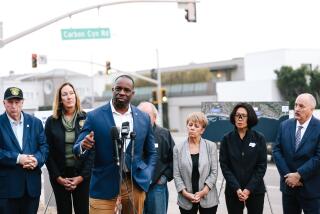Hate to Buckle Up? Avoiding It Is a Bigger Pain Than You Think
- Share via
No one relishes the thought of being thrown to the pavement in a car wreck, but lots of motorists still come up with reasons not to buckle up. Seat belts are uncomfortable. They wrinkle your clothes. They can be, literally, a pain in the neck.
And with all the new safety features available in new cars, such as air bags and automatic shoulder straps, are seat belts really vital to your safety?
You better believe it.
California has seen a steady decline in highway fatalities over the past few years. Although highway safety efforts have been multifaceted, more-stringent laws mandating safety restraints have played the most significant role in keeping people alive, officials say.
“We can’t attribute the decreased deaths to one factor, but increased safety belt usage constitutes the biggest part because it has the widest application,” said Steve Kohler, a spokesman for the California Highway Patrol. “More of the population is affected--and can be affected--by safety restraints than by, say, drunk driving laws.”
Although figures are not available for the year coming to a close, the National Highway Traffic Safety Administration says that an average of 110 people died on the nation’s roads each day in 1993--one every 13 minutes.
On California surface streets and state highways, one person was killed every 2 hours and 6 minutes. One person was injured in a traffic accident every 1 minute and 40 seconds. That makes for 76 injuries for every traffic death.
*
Since 1990, the CHP has analyzed whether people killed in traffic accidents while not wearing seat belts could have survived if they had taken the time to buckle up. In 1993, 1,060 people killed in traffic accidents were not wearing seat belts. Two-thirds could have survived if they had used safety restraints, the CHP estimated.
However, Californians are more likely than other motorists in the nation to use seat belts. The CHP estimates that 83% of Californians buckled up in 1993. Nationally, the average was 62%. According to Kohler, the increased use of seat belts in California reveals the powerful effects of vehicle restraints.
“Only 1 in 2 Californians buckled up in 1988. Now that ratio exceeds 4 in 5,” Kohler said. During the same five years, the mileage death rate per 100 million vehicle miles of travel plunged from 2.3 to 1.56.
The rise in seat belt use in California has jumped in tandem with the tightening of legislation regarding their use.
California was one of the first states to adopt the Primary Safety Belt Law, which means that officers may stop and cite a driver simply for failing to wear a seat belt. Before 1993, an unbelted person could be cited only when stopped for another violation.
Use of seat belts has increased from 12% to 16% each of the several times the state has tightened its laws over the years.
*
Simply buckling up that belt is not enough. There are right and wrong ways to wear a seat belt. The lap belt should be worn low and tight across the abdomen and high across the shoulder.
“They need to be tight to really be secure, but if you find it uncomfortable, you are not going to wear it,” Pulley said. “Generally, if you loosen it up enough to slide your fisted hand between your body and the belt, you should be both comfortable and safe.”
Pulley also warned against the habit of wearing the shoulder strap either beneath the arm or behind the back. Both practices severely limit or eliminate the protection provided by the shoulder belt and can increase trauma to the abdomen in case of an accident.
Also dangerous is the notion that the automatic shoulder belt available in some cars provides adequate protection. If the lap belt is not fastened, the shoulder belt may not catch.
“Without the lap restraint, you are likely to submarine-out from under the shoulder belt into the steering column, increasing injury to your lower body,” Pulley said.
And air bags, Pulley said, offer no protection from being thrown around the car during a crash. Recent studies show that even when they do inflate, air bags alone offer only minimal protection.
In two years, 95% of all new cars will be required to have both driver-side and passenger-side air bags. By 1998, all new cars will have to meet that standard.
President Clinton has said he wants to see seat belt usage raised from the 62% to 70% nationwide by the end of his term. As David Alexander of the National Safety Council noted: “Sixty-two percent of the nation wearing seat belts means that 38% still are not. . . . Pledging to make sure that you are belted up, and that every passenger in your car is properly restrained, would be a good New Year’s resolution for everyone.”
(BEGIN TEXT OF INFOBOX / INFOGRAPHIC)
Seat Belts and Safety
California Highway Patrol officers investigating fatal traffic accidents try to determine how seat belts would have saved lives. Statewide figures below apply to roadways under the jurisdiction of the CHP:
Percentage of those Percentage fatalities who would fatalities not have lived had they Year Fatalities wearing seat belts worn seatbelts 1990 2307 73% 70% 1991 2152 72% 64% 1992 1888 70% 66% 1993 1804 59% 65%
More to Read
Sign up for Essential California
The most important California stories and recommendations in your inbox every morning.
You may occasionally receive promotional content from the Los Angeles Times.










